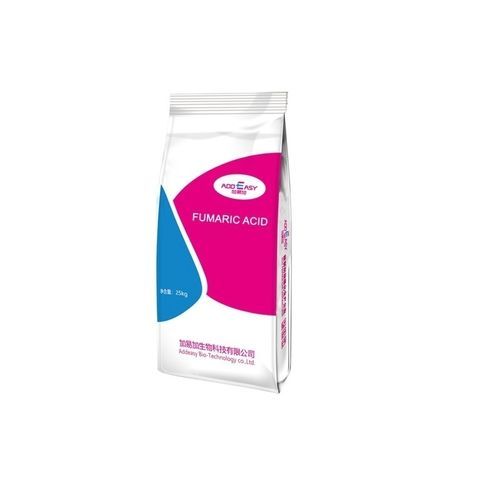
- Livestock Farming
- Animal feed
- Antioxidant feed additive
- ADDEASY BIO-TECH

- Products
- Catalogs
- News & Trends
- Exhibitions
Acidifier feed additive antioxidantpoultryfor pigs
Add to favorites
Compare this product
Characteristics
- Type
- acidifier, antioxidant
- Animal type
- poultry, for pigs, cattle, sheep, goat, for horses
- Form
- dry
Description
Other Names: 2-BUTENEDIOIC ACID,TRANS-2-BUTENEDIOIC ACID,LICHENIC ACID,TRANS-1,
2-ETHYLENEDICARBOXYLIC ACID,FA
Specification: Feed Grade
CAS No.: 110-17-8
Molecular Formular: C4H4O4
Molecular Weight: 116.07
Packing: In 25kg plastic woven lined with PE bag net each.
1, Food additives
Fumaric acid can be used as sour flavor agent, used in soft drinks, fruits, ice cream and other food fields, can also be used as acidity regulator, antioxidant additives, curing accelerator, used in pickled vegetables, meat products, seafood products and other food fields.
2, Resin
Fumaric acid is an important raw material for the production of unsaturated polyester resin.
3, Pharmaceutical field
mainly used for the production of antidotes dimercaptosuccinic acid and anti-anemia drugs iron fumaric acid production.
4, chemical field
Fumaric acid can be used to produce fumaric acid ester, fumaric acid dimethyl ester, fumaric acid and other organic synthetic polymer compounds.
5, coating
Fumaric acid can be used to produce tri octyl fumarate/n-butyl alcohol substitute solvent, nitroglycerol solvent, butyl acrylate/styrene copolymerization emulsion and other coating products.
6, agricultural field
Fumaric acid can be used to produce pesticides, leaf fertilizer, but also as a biological accelerator, promote plant growth and nutrient absorption.
7, others
Fumaric acid can also be used in animal husbandry, electronic chemicals, adhesives, lubricants, dispersants, resin finishing agents, polymerization reaction initiator and other fields.
Related Searches
- Feed additive
- Dry feed additive
- Poultry feed additive
- Cattle feed additive
- Pig feed additive
- Liquid feed additive
- Acidifier feed additive
- Antibacterial feed additive
- Sheep feed additive
- Fish feed additive
- Powder feed additive
- Preservative feed additive
- Goat feed additive
- Equine feed additive
- Antioxidant feed additive
- Growth enhancer feed additive
- Cows feed additive
- Anti-scour feed additive
- Flavor enhancer feed additive
- Anti-inflammatory feed additive
*Prices are pre-tax. They exclude delivery charges and customs duties and do not include additional charges for installation or activation options. Prices are indicative only and may vary by country, with changes to the cost of raw materials and exchange rates.


